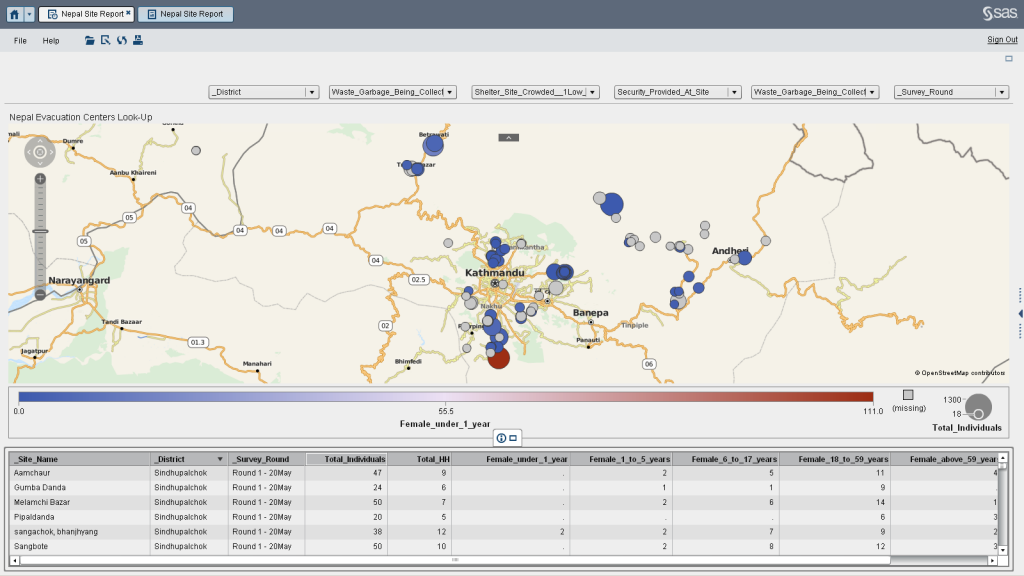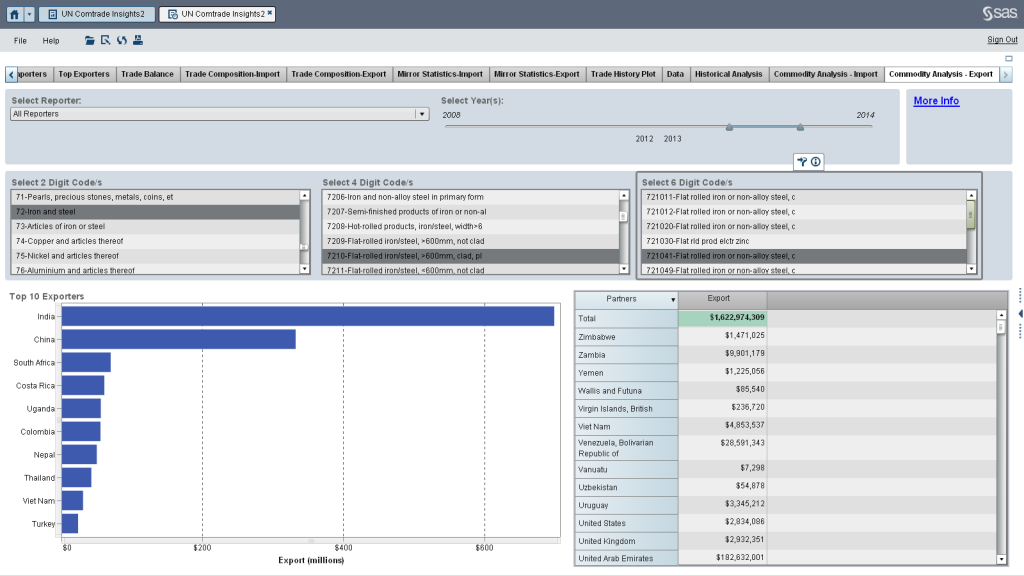As monsoon season begins, many Nepal earthquake victims have shelter over their heads thanks in part to an unlikely intersection of two SAS global development projects.
The first project is with the International Organization for Migration (IOM). IOM is the first responder to any crisis that displaces people. IOM provides temporary shelter and helps coordinate the efforts of other relief agencies that provide food, clean water, medical care and security.
IOM is currently assisting thousands of victims in the earthquake-ravaged areas of Nepal. SAS is helping IOM analyze shelter data to help better allocate resources, based on the work we did with them following Typhoon Haiyan in the Philippines.
Using SAS Visual Analytics, IOM can see where the high-risk shelters are, based on factors such as:
- A dangerous mix of overcrowding, unsafe drinking water and solid waste disposal problems.
- High numbers of families still living in makeshift shelters.
- Rapid growth of certain vulnerable populations in a short amount of time.
- Higher concentrations of diarrhea, fever and skin disease among older people.
As new data comes in, new insights are revealed. As you would expect, Kathmandu is the focus of the bulk of relief efforts. However, after visualizing data on young children, it was revealed that a nearby district had more small children, ages 1-5, and in particular, five times the number of infant girls as Kathmandu. This smaller district had a larger need for diapers, formula, children’s medicine and other supplies for nursing moms. These were quick, but important, insights to guide relief efforts.

How can global trade data inform disaster relief?
There’s another side to the Nepal data story, though. In April, SAS announced the launch of SAS Visual Analytics for UN Comtrade, which made 27 years of international trade data available using data visualization software. How is this helping with the Nepal earthquake response?
IOM is building temporary shelters for displaced people in Nepal and needed to understand where/how to quickly procure sheet metal roofing (CGI) before monsoon season. People are sleeping out in the open due to the fear that more aftershocks will bring buildings down on them, so protection during monsoon season is a big concern.
Using UN Comtrade, we were able to show IOM a graphic of the top exporters of CGI. Some of the findings include:
- Neighboring India is the world’s largest producer of CGI roofing sheets that are wider than 24 inches, but India rarely sells it to Nepal.
- Nepal is actually the world’s 7th largest producer so historically there’s good capacity for CGI fabrication in Nepal. Consequently, some of the supply can be sourced locally.
- There are other potential sellers in the region like China (2nd), Thailand (8th) and Vietnam (9th).

Top exporters of CGI roofing sheets, via SAS Visual Analytics for UN Comtrade (click to enlarge)
Brian Kelly, who is leading the Nepal response for IOM, shared his thoughts. “Shelter is so important to helping the 63,000 displaced families create a level of stability and protection, especially with monsoon season upon us. With the UN Comtrade information, we were able to secure materials more quickly and, literally, put roofs over peoples’ heads.”
A new era of data-for-good
These projects just scratch the surface of what’s possible when new data, and those that know how to use it, are applied to humanitarian needs. Organizations such as DataKind and INFORMS, through its new Pro Bono Analytics program, are rallying data scientists to lend their time and expertise to helping people around the world. And there are many more data sets out there that could help with relief and other humanitarian efforts.
It’s an exciting time to be in the world of big data and analytics. We’re just beginning to understand how technology can tackle society’s “grand challenges.” Please share your ideas on what unlikely data sources might help with disaster relief. And, how can we bring the world’s analytics talent to bear on these challenges?


11 Comments
Technology/humanity, just plain awesome!
These are great examples of Data for Good!
Maybe a complimentary piece is the Definitive Guide to Do Data Science for Good.
Another way to start working on a data-driven project for social good right now is the #openimpact replication marathon.
Great piece illustrating how powerful using data in the service of humanity can be! Honored to be mentioned in it - our Singapore and Bangalore Chapters have both contributed to data-for-good Nepal relief efforts and our good friends, GlobalGiving, have also been helping to raise funds. So many groups out there are doing tremendous work in this space - Ushahidi, Humanitarian Data Exchange and Digital Humanitarian Network to name a few! http://www.ushahidi.com/2015/04/25/supporting-online-volunteer-response-to-the-nepal-earthquake/
The way I see it, it is possible to observe animal behaviour before an earthquake. In others of these disasters it has been observed that animals leave the area or change reaction patterns. A possible gathering of this type of data would level up predictive analytics. Thus save human lives. What is being done at the moment by SAS and others is true example of Data for good.
This is a just one example of what technology can do for the mankind if used in the right manner. I have been working with SAS and most of its tools for the last 7-8 years and would really like to contribute in helping our society. If anyone has any contacts to get in touch with organisations who are looking for volunteers please let me know.
I Am one of Nepali, Who is workin on SAS, having 3+ years of coding experience.
Having good exposure on macros, I can be a voleentr for this analysis , please contact me if possible.And thankful for this project team..
Pingback: Doing good with data and analytics - The Corner Office
I believe having a visibility of funds / type of relief in a visualisation form can really help in estimating the required funds and in planning. Also, predicting the spread of a disease / infection can help in placing the control measures effectively and to deal with shortage of medical help.
Pingback: TEDx RheinMain: Big Data Analytics "Data for Good" - Mehr Wissen
Good Job
Thank you SAS for helping to my birthplace Nepal and leveraging the technology.
Loving SAS.